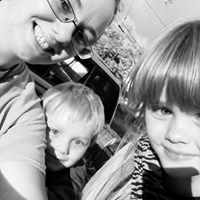Kasey R Myers
age ~50
from Auburn, AL
- Also known as:
-
- Kasey Robert Myers
- Kasey A Myers
- Casey R Myers
- Phone and address:
-
1483 Arrowhead Cir, Auburn, AL 36830
(334)4159874
Kasey Myers Phones & Addresses
- 1483 Arrowhead Cir, Auburn, AL 36830 • (334)4159874
- 1797 Coopers Pond Rd, Auburn, AL 36830 • (334)8268810
- Granbury, TX
- 707 Rutledge St, Spartanburg, SC 29302 • (864)5822883
- Wetumpka, AL
- Lagrange, GA
Work
-
Company:Gkn aerospace - Tallassee, ALJan 2012
-
Position:General manager
Education
-
School / High School:Auburn University- Auburn, AL1998
-
Specialities:B.S in Textile Engineering
Us Patents
-
Process For Creating Fabrics With Branched Fibrils And Such Fibrillated Fabrics
view source -
US Patent:20060166578, Jul 27, 2006
-
Filed:Jan 21, 2005
-
Appl. No.:11/040211
-
Inventors:Kasey Myers - Spartanburg SC, US
Franklin Love - Columbus NC, US
Kirkland Vogt - Simpsonville SC, US -
International Classification:D04G 1/00
-
US Classification:442001000, 442181000
-
Abstract:The present process involves applying a plasticizer- or solvent-containing solution to a subject fabric, preferably under heated conditions, and then mechanically abrading the treated fabric. The process results in the rearrangement of the fabric structure, as a plurality of branched fibrils are created along the length of the yarn filaments. Thus, the molecular weight of the fabric's yarns and, therefore, the strength of the polymer chains are maintained. Fabrics made from this process, which exhibit a silk-like hand that results from the presence of multiple integral fibrils and branched fibrils, are also provided.
-
Process For Creating Fabrics With Branched Fibrils And Such Fibrillated Fabrics
view source -
US Patent:20070020455, Jan 25, 2007
-
Filed:Sep 29, 2006
-
Appl. No.:11/540053
-
Inventors:Kasey Myers - Spartanburg SC, US
Franklin Love - Columbus NC, US
Kirkland Vogt - Simpsonville SC, US -
International Classification:D02G 3/00
-
US Classification:428399000, 428397000, 428400000
-
Abstract:The present process involves applying a plasticizer- or solvent-containing solution to a subject fabric, preferably under heated conditions, and then mechanically abrading the treated fabric. The process results in the rearrangement of the fabric structure, as a plurality of branched fibrils are created along the length of the yarn filaments. Thus, the molecular weight of the fabric's yarns and, therefore, the strength of the polymer chains are maintained. Fabrics made from this process, which exhibit a silk-like hand that results from the presence of multiple integral fibrils and branched fibrils, are also provided.
-
Process For Creating Fabrics With Branched Fibrils
view source -
US Patent:20070022587, Feb 1, 2007
-
Filed:Sep 29, 2006
-
Appl. No.:11/540054
-
Inventors:Kasey Myers - Spartanburg SC, US
Franklin Love - Columbus NC, US
Kirkland Vogt - Simpsonville SC, US -
International Classification:D06C 11/00
D06C 29/00 -
US Classification:028167000, 428091000
-
Abstract:The present process involves applying a plasticizer- or solvent-containing solution to a subject fabric, preferably under heated conditions, and then mechanically abrading the treated fabric. The process results in the rearrangement of the fabric structure, as a plurality of branched fibrils are created along the length of the yarn filaments. Thus, the molecular weight of the fabric's yarns and, therefore, the strength of the polymer chains are maintained. Fabrics made from this process, which exhibit a silk-like hand that results from the presence of multiple integral fibrils and branched fibrils, are also provided.
-
Flexible Sheet-Like Composites
view source -
US Patent:20070128963, Jun 7, 2007
-
Filed:Aug 23, 2006
-
Appl. No.:11/508623
-
Inventors:Kirkland Vogt - Simpsonville SC, US
Karl Gruenberg - Spartanburg SC, US
John Sollars - LaGrange GA, US
Carlton Senn - LaGrange GA, US
Stophon Waddell - Easloy SC, US
Kasey Myers - Auburn AL, US -
International Classification:B32B 27/12
B32B 27/04
B32B 5/02 -
US Classification:442301000, 442286000, 442038000, 442043000, 442045000
-
Abstract:Provided herein are various flexible sheet-like substrates that are lightweight, rupture or burst resistant, and suitable for use in constructing a variety of structures used in fluid-containment, especially gas containment, and other applications, and the processes by which such composites can be fabricated. In the most general case, the composites of this disclosure are comprised of a woven textile fabric to which has been laminated a flexible film. Two principal embodiments are disclosed: a first embodiment without a reinforcing layer, and a second embodiment with a structurally robust, bias-oriented reinforcing layer, preferably interposed between the fabric and the film.
-
Child Resistant Container And Method Of Opening Same
view source -
US Patent:20210284402, Sep 16, 2021
-
Filed:Dec 18, 2020
-
Appl. No.:17/247666
-
Inventors:- Auburn AL, US
Brian Tifft - Auburn AL, US
Ethan Ross Perdue - Auburn AL, US
Kasey Myers - Auburn AL, US
Jean-Pierre Giraud - Auburn AL, US
Anthony Hamilton - Cullman AL, US -
International Classification:B65D 50/06
B65D 43/16 -
Abstract:A child resistant container is for containing at least one product, such as medicine. The child resistant container includes a body, a lid, and a directing portion. The body has an end portion defining an opening leading to an interior of the body. The lid is connected to the body via a hinge, and includes a cover portion and a protrusion extending outwardly therefrom. The cover portion is configured to move between a FIRST position corresponding to the cover portion covering the opening, and a SECOND position corresponding to the cover portion not covering the opening. The directing portion extends from one of the body and the cover portion, and at least partially encloses the protrusion when the cover portion is in the FIRST position. When the cover portion moves from the FIRST position to the SECOND position, the protrusion moves away from the directing portion.
-
Container Apparatus, Methods For Opening Containers And Zipper Member For A Container Apparatus
view source -
US Patent:20200361676, Nov 19, 2020
-
Filed:Nov 9, 2018
-
Appl. No.:16/762825
-
Inventors:- Auburn AL, US
Trevor Johnson - Auburn AL, US
Jean-Pierre Giraud - Auburn AL, US
Ethan Ross Perdue - Auburn AL, US
Brian Tifft - Auburn AL, US
Kasey Myers - Auburn AL, US -
International Classification:B65D 50/06
A61J 1/03
A61J 1/14 -
Abstract:Container apparatus embodiments for providing preferably child resistant and senior friendly closures are provided. Generally, the embodiments include containers, each having an internal product space configured for housing at least one product. Generally, the container apparatus embodiments are each configured to move between a CLOSED position and an OPENED position. Various mechanisms according to the disclosed concepts are described to help prevent a person who should not be accessing contents of the container apparatus from doing so.
-
Containers, Container Inserts And Associated Methods For Making Containers
view source -
US Patent:20190367222, Dec 5, 2019
-
Filed:Sep 15, 2017
-
Appl. No.:16/334105
-
Inventors:- Auburn AL, US
Kasey MYERS - Auburn AL, US
Ethan Ross PERDUE - Auburn AL, US -
International Classification:B65D 43/16
B65D 47/08
B01L 3/00 -
Abstract:A container () includes a container body () having a base (), a sidewall (), and a body extension portion (), the body extension portion terminates at a body extension outer surface; a lid () connected to the container body and that is pivotable to move the container between a closed position and an open position, the lid comprising a cover portion () and a lid extension portion () extending therefrom and terminating at a lid extension outer surface, the lid extension portion having an underside. The body extension outer surface and the lid extension outer surface are generally co-planar when the container is in the closed position. The body extension portion hits n window () configured to provide access to the underside when the container is in the closed position to enable a user to apply upward pressure on the underside to move the container from the closed position to the open position.
-
Child Resistant Container And Method Of Opening Same
view source -
US Patent:20180305093, Oct 25, 2018
-
Filed:Apr 24, 2018
-
Appl. No.:15/960727
-
Inventors:- Auburn AL, US
Brian Tifft - Auburn AL, US
Ethan Ross Perdue - Auburn AL, US
Kasey Myers - Auburn AL, US
Jean-Pierre Giraud - Auburn AL, US
Anthony Hamilton - Cullman AL, US -
International Classification:B65D 50/06
B65D 43/16 -
Abstract:A child resistant container is for containing at least one product, such as medicine. The child resistant container includes a body, a lid, and a directing portion. The body has an end portion defining an opening leading to an interior of the body. The lid is connected to the body via a hinge, and includes a cover portion and a protrusion extending outwardly therefrom. The cover portion is configured to move between a FIRST position corresponding to the cover portion covering the opening, and a SECOND position corresponding to the cover portion not covering the opening. The directing portion extends from one of the body and the cover portion, and at least partially encloses the protrusion when the cover portion is in the FIRST position. When the cover portion moves from the FIRST position to the SECOND position, the protrusion moves away from the directing portion.
Resumes

Program Manager
view sourceLocation:
Auburn, AL
Industry:
Plastics
Work:
Csp Technologies, Inc.
Program Manager
Gkn Aerospace 2012 - 2014
General Manager
Gkn Aerospace 2009 - 2012
Head of Operations and Engineering
Gkn Aerospace 2007 - 2009
Senior Aerospace Composites Engineer and Technical Manager
Milliken & Company 2006 - 2007
Senior Development Engineer
Program Manager
Gkn Aerospace 2012 - 2014
General Manager
Gkn Aerospace 2009 - 2012
Head of Operations and Engineering
Gkn Aerospace 2007 - 2009
Senior Aerospace Composites Engineer and Technical Manager
Milliken & Company 2006 - 2007
Senior Development Engineer
Education:
Auburn University 2015 - 2019
Master of Science, Masters Auburn University 1994 - 2000
Master of Science, Masters
Master of Science, Masters Auburn University 1994 - 2000
Master of Science, Masters
Skills:
Lean Manufacturing
Continuous Improvement
Manufacturing
Process Engineering
Engineering
Kaizen
Aerospace
Value Stream Mapping
Six Sigma
Engineering Management
Composites
Leadership
Program Management
Process Improvement
Aircraft
Manufacturing Engineering
Systems Engineering
Business Development
Root Cause Analysis
Dmaic
Supply Chain Management
Product Development
Manufacturing Operations Management
Project Management
5S
Quality Management
Procurement
Spc
Technology Transfer
Operations Management
Coatings
Iso
Aviation
Quality System
Continuous Improvement
Manufacturing
Process Engineering
Engineering
Kaizen
Aerospace
Value Stream Mapping
Six Sigma
Engineering Management
Composites
Leadership
Program Management
Process Improvement
Aircraft
Manufacturing Engineering
Systems Engineering
Business Development
Root Cause Analysis
Dmaic
Supply Chain Management
Product Development
Manufacturing Operations Management
Project Management
5S
Quality Management
Procurement
Spc
Technology Transfer
Operations Management
Coatings
Iso
Aviation
Quality System
Interests:
Economic Empowerment

Kasey Myers
view sourceLocation:
Auburn, AL
Skills:
Presses
Aerospace
Design
Process Design
Fuel Cells
Process Engineering
Composites
Military
Aircraft
Operations
Carbon Fiber
Aerospace
Design
Process Design
Fuel Cells
Process Engineering
Composites
Military
Aircraft
Operations
Carbon Fiber

Kasey Myers
view source
Kasey Myers
view source
Combat Engineer
view sourceWork:
Army
Combat Engineer
Combat Engineer

Kasey Myers
view source
Kasey Myers Auburn, AL
view sourceWork:
GKN Aerospace
Tallassee, AL
Jan 2012 to Aug 2014
General Manager Alabama Workforce Council
Jul 2014 to Jul 2014 Manufacture Alabama
Active, AL
2009 to 2014
GKN Representative GKN Aerospace
2007 to 2014 Auburn University
2007 to 2014 GKN Aerospace
Tallassee, AL
Sep 2009 to Dec 2011
Head of Engineering and Operations GKN Aerospace
Tallassee, AL
Mar 2007 to Sep 2009
Sr. Engineer, Technical Programs Manager Milliken & Co
Spartanburg, SC
Oct 2006 to Mar 2007
Senior Development Engineer Milliken & Co
2000 to 2007 Milliken & Co
LaGrange, GA
Feb 2006 to Oct 2006
Senior Production Manager Milliken & Co
Manchester
May 2005 to Feb 2006
International Project Manager Milliken & Co
Spartanburg, SC
Sep 2002 to May 2005
Research Engineer Milliken & Co
LaGrange, GA
Sep 2000 to Sep 2002
Process Engineer
Tallassee, AL
Jan 2012 to Aug 2014
General Manager Alabama Workforce Council
Jul 2014 to Jul 2014 Manufacture Alabama
Active, AL
2009 to 2014
GKN Representative GKN Aerospace
2007 to 2014 Auburn University
2007 to 2014 GKN Aerospace
Tallassee, AL
Sep 2009 to Dec 2011
Head of Engineering and Operations GKN Aerospace
Tallassee, AL
Mar 2007 to Sep 2009
Sr. Engineer, Technical Programs Manager Milliken & Co
Spartanburg, SC
Oct 2006 to Mar 2007
Senior Development Engineer Milliken & Co
2000 to 2007 Milliken & Co
LaGrange, GA
Feb 2006 to Oct 2006
Senior Production Manager Milliken & Co
Manchester
May 2005 to Feb 2006
International Project Manager Milliken & Co
Spartanburg, SC
Sep 2002 to May 2005
Research Engineer Milliken & Co
LaGrange, GA
Sep 2000 to Sep 2002
Process Engineer
Education:
Auburn University
Auburn, AL
1998
B.S in Textile Engineering
Auburn, AL
1998
B.S in Textile Engineering
Googleplus

Kasey Myers
Education:
University of Phoenix
Relationship:
Married
About:
I am a 31 year old wife of 13 years and a mother of 2 butifull boys they are 11 and 6 they are my life. i am curently a stay at home mom and a full time collage student at the university of phoenix th...

Kasey Myers
Relationship:
Engaged

Kasey Myers

Kasey Myers
Tagline:
I have a shitload of class.

Kasey Myers

Kasey Myers
view source
Casey Myers Cook
view source
Kasey Myers
view source
Kasey Myers
view source
Kasey Myers
view source
Kasey Myers
view source
Kasey Myers
view source
Casey Myers Funeral Home
view sourceMyspace
Classmates

Kasey Myers (Hebert)
view sourceSchools:
Sumner High School Kentwood LA 1989-1993
Community:
Sherita Lewis, Deanna Carrier, Frank Eldridge, Rebekah Webber, Robert Warner

Kasey Myers
view sourceSchools:
Salk Elementary School Anaheim CA 1990-1997, Dale Junior High School Anaheim CA 1997-1998
Community:
Alice Archer

Kasey Myers
view sourceSchools:
Kent Island High School Stevensville MD 2002-2006
Community:
Kayla Smith

Kasey Fitzgerald (Myers)
view sourceSchools:
Harrison Elementary School Canon City CO 1982-1986, Canon City Junior High School Canon City CO 1986-1988
Community:
William Beeler, Tom Mcgraw, Kenneth Laplaunt, Jerry Merris

casey myers, Lamesa High ...
view source
Kent Island High School, ...
view sourceGraduates:
Kasey Myers (2002-2006),
Sean McGee (1997-1998),
David Catterton (1996-2000),
Adam Martin (1998-2002),
Nicole Cox (1996-2000)
Sean McGee (1997-1998),
David Catterton (1996-2000),
Adam Martin (1998-2002),
Nicole Cox (1996-2000)

Salk Elementary School, A...
view sourceGraduates:
Kasey Myers (1990-1997),
Thomas Pfeifer (1969-1970),
Melanie Chung (2000-2004),
Rose Herrmann (1976-1979)
Thomas Pfeifer (1969-1970),
Melanie Chung (2000-2004),
Rose Herrmann (1976-1979)
Youtube
Get Report for Kasey R Myers from Auburn, AL, age ~50











